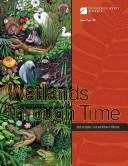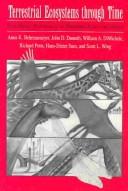| Listing 1 - 9 of 9 |
Sort by
|

ISBN: 081372399X 9780813723990 Year: 2006 Publisher: Boulder, Colo. : Geological Society of America,
Abstract | Keywords | Export | Availability | Bookmark
 Loading...
Loading...Choose an application
- Reference Manager
- EndNote
- RefWorks (Direct export to RefWorks)
Article
Abstract | Keywords | Export | Availability | Bookmark
 Loading...
Loading...Choose an application
- Reference Manager
- EndNote
- RefWorks (Direct export to RefWorks)
Article
Abstract | Keywords | Export | Availability | Bookmark
 Loading...
Loading...Choose an application
- Reference Manager
- EndNote
- RefWorks (Direct export to RefWorks)
Book
Year: 2017 Publisher: Washington, D.C. : Smithsonian Institution Scholarly Press,
Abstract | Keywords | Export | Availability | Bookmark
 Loading...
Loading...Choose an application
- Reference Manager
- EndNote
- RefWorks (Direct export to RefWorks)
Plants, Fossil --- Paleobotany --- Paleobiology --- Geology, Stratigraphic
Book
ISBN: 0931377021 Year: 1988 Publisher: Tulsa : The Paleontological Society,
Abstract | Keywords | Export | Availability | Bookmark
 Loading...
Loading...Choose an application
- Reference Manager
- EndNote
- RefWorks (Direct export to RefWorks)
Book
Year: 2006 Publisher: Geological Society of America
Abstract | Keywords | Export | Availability | Bookmark
 Loading...
Loading...Choose an application
- Reference Manager
- EndNote
- RefWorks (Direct export to RefWorks)
Paleoecology --- Paleoecology --- Wetlands --- History.

ISBN: 0226041557 0226041549 Year: 1992 Publisher: Chicago, Ill. University of Chicago Press
Abstract | Keywords | Export | Availability | Bookmark
 Loading...
Loading...Choose an application
- Reference Manager
- EndNote
- RefWorks (Direct export to RefWorks)
Breathtaking in scope, this is the first survey of the entire ecological history of life on land--from the earliest traces of terrestrial organisms over 400 million years ago to the beginning of human agriculture. By providing myriad insights into the unique ecological information contained in the fossil record, it establishes a new and ambitious basis for the study of evolutionary paleoecology of land ecosystems. A joint undertaking of the Evolution of Terrestrial Ecosystems Consortium at the National Museum of Natural History, Smithsonian Institution, and twenty-six additional researchers, this book begins with four chapters that lay out the theoretical background and methodology of the science of evolutionary paleoecology. Included are a comprehensive review of the taphonomy and paleoenvironmental settings of fossil deposits as well as guidelines for developing ecological characterizations of extinct organisms and the communities in which they lived. The remaining three chapters treat the history of terrestrial ecosystems through geological time, emphasizing how ecological interactions have changed, the rate and tempo of ecosystem change, the role of exogenous "forcing factors" in generating ecological change, and the effect of ecological factors on the evolution of biological diversity. The six principal authors of this volume are all associated with the Evolution of Terrestrial Ecosystems program at the National Museum of Natural History, Smithsonian Institution.
Evolution. Phylogeny --- General ecology and biosociology --- General palaeontology --- Paleo-ecologie --- Paleobiologie --- Paleobiology --- Paleoecology --- Paléobiologie --- Paléoécologie --- Evolutionary paleoecology. --- Paleoecology. --- Paleobiology. --- Evolutionary paleoecology --- Evolutionary paleobiology
Book
Year: 2017 Publisher: Washington (D.C.): Smithsonian institution scholarly press,
Abstract | Keywords | Export | Availability | Bookmark
 Loading...
Loading...Choose an application
- Reference Manager
- EndNote
- RefWorks (Direct export to RefWorks)
Plant fossils are described from five stratigraphic levels in upper Paleozoic strata in Abo Canyon, New Mexico. The fossils were collected by Charles B. Read, of the U.S. Geological Survey, in 1940 and 1941, and span the Pennsylvanian-Permian boundary. Read's original field notes have not been located. However, a combination of his pattern of bed numbering, notes written by Read and enclosed with the collections, and the taxonomic composition of the floras permit them to be placed with confidence in a sequence from oldest to youngest. The youngest fossils, which securely anchor the entire collection stratigraphically, are from the Abo Formation and are of early Permian age. A collection labeled "Base of Red Magdalena" is most likely from what today would be termed the Bursum Formation, thus immediately below the Abo. The three remaining collections are from the Pennsylvanian-aged Atrasado Formation, probably the Upper Pennsylvanian portion, extending as far back as the Missourian. The collections record a trend of increased seasonality of moisture (likely rainfall) through time. They are all either dominated or co-dominated by plants typical of environments with seasonal moisture stress. Conifers, Sphenopteris germanica and mixoneurid odontopterids are common to abundant in the collections older than the Abo Formation. All of the assemblages from below the Abo Formation also contain some taxa that required wet substrates for most of the year, particularly calamitaleans and marattialean tree ferns; the oldest collection also contains evidence of arborescent lycopsids
Plants, Fossil --- Paleobotany --- Paleobotany --- Paleobiology --- Geology, Stratigraphic --- Geology, Stratigraphic
Book

ISBN: 9780231528528 Year: 2001 Publisher: New York, NY
Abstract | Keywords | Export | Availability | Bookmark
 Loading...
Loading...Choose an application
- Reference Manager
- EndNote
- RefWorks (Direct export to RefWorks)
| Listing 1 - 9 of 9 |
Sort by
|

 Search
Search Feedback
Feedback About UniCat
About UniCat  Help
Help News
News